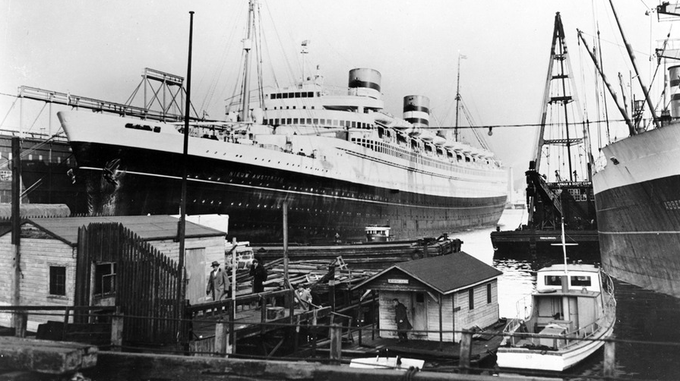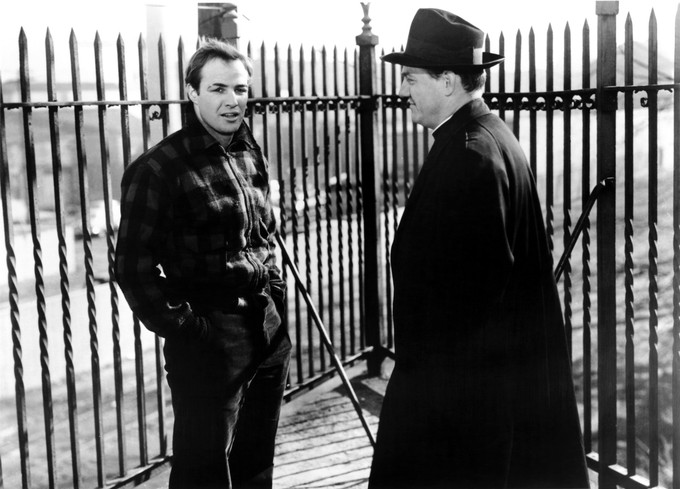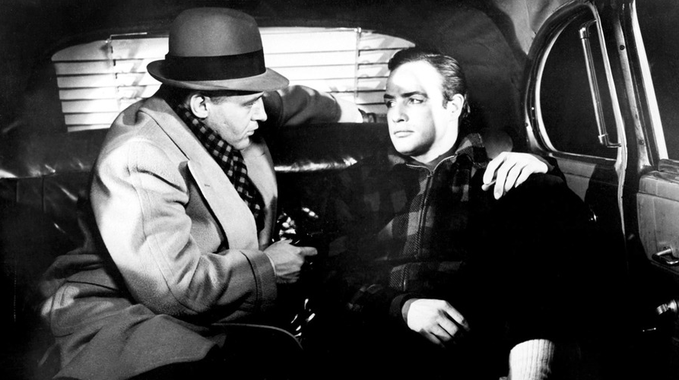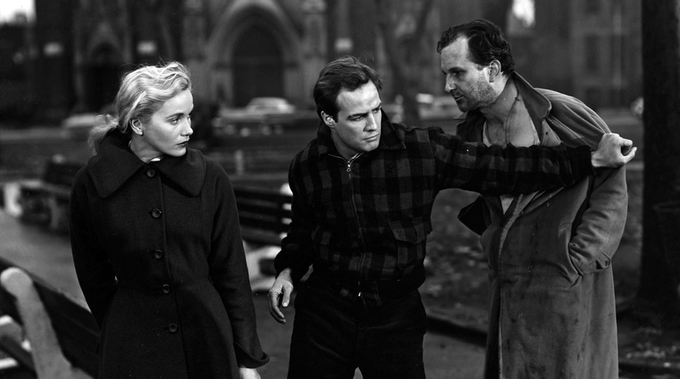What’s up, Contenders? Terry Malloy here reporting live from the Waterfront.
I have long felt that ON THE WATERFRONT is the greatest film ever made. And now The Criterion Collection has given all of us a great gift with their Blu-ray of the film, which is easily the new definitive home viewing experience for this masterwork. If you’ve never seen ON THE WATERFRONT, now is very definitely the right time. This release has the power to present the film to you with the finest digital restoration money can buy, and then to immerse you in rich supplemental material that engages viewers for hours. So yes, this Criterion Edition takes us to new heights of enjoyment with this uncontested classic. But before we dig into what is under the hood of this home video release, we have to spend some time with the centerpiece; the film itself
I first saw ON THE WATERFRONT when I was younger and smarter and trying to watch all of the American Film Institute’s Top 100 American Films of All Time list. I have yet to complete that list, much to my dismay, but I’ll always owe AFI a debt of gratitude for being the catalyst that put ON THE WATERFRONT before my eye sockets. (They list ON THE WATERFRONT as the 8th greatest American film, for the record.
The film opens in a spectacular wide shot that tells the whole story in a single frame. The docks of New York City, present day, 1954.

An enormous freighter looms in the background and a small floating barge is nestled in the foreground. This is the clubhouse of the local union. And out of this little barge emerge Johnny Friendly (Lee J. Cobb), Charley The Gent (Rod Steiger), a bevy of henchmen, and Terry Malloy (Marlon Brando). Friendly’s gang all go one way, Malloy goes the other. And in many ways that is the whole story that ON THE WATERFRONT is about to tell you.
Malloy is headed off to pay a visit to Joey Doyle, just to coax him out of his apartment with a friendly face so that Johnny’s men can rough him up a little. Doyle is considering testifying in court against Friendly and his corrupt union that is holding the waterfront dock workers in its iron grip. So it will come as no surprise to anyone (except perhaps Terry Malloy) that once Joey steps out onto the roof of his apartment building, it will be the last thing he ever does.
Upon Joey’s death we meet his beautiful younger sister Edie (Eva Marie Saint), and Father Barry (Karl Malden) and these characters are the final elements of a perfect storm that will send Terry Malloy’s life reeling towards redemption.

Edie is heartbroken at the loss of her brother and will stick her nose in all sorts of places that it doesn’t belong in order to find out who killed Joey. Edie’s determination inspires Father Barry to get out of his parish and get down to the docks, bringing his ministry out into the streets.
Edie and Father Barry command a small edge of respect and reverence on the docks, as a beautiful young woman and a Catholic priest in an Irish town are wont to do. So when they start piecing together the corrupt system of the Local run by Johnny Friendly, they begin encouraging the dock workers to talk to the Port Authority.
The rest of the film will weave a powerful and authentic tale of a washed up ex-fighter who has spent his life taking orders from his older brother Charley the Gent and Johnny Friendly’s gang. Terry Malloy isn’t the brightest. But when he finds love with Edie, the seeds of redemption from Father Doyle, and ultimately sees through the façade of the system that has kept him down; Malloy will undergo a heroic and redemptive journey that rivals the best ever told. And not everyone will make it out alive.
I can very clearly identify why the film had such a profound impact on me right from the first viewing. For one thing, ON THE WATERFRONT is a gangster movie. Sure, the gang here is technically a labor union, but they are gangsters all the same. And I love gangsters. So this film was speaking my language! On top of that though, ON THE WATERFRONT is a powerful redemption story, bolstered by religious language and imagery that was very powerful to me as a young man who was training to go into the ministry. Re-watching the film today, those initial elements still speak to me powerfully and draw me in. But each time I revisit the film I learn more about the history behind it, and new elements come to the forefront and cause me to love the film even more.
ELIA KAZAN, Director
Widely considered one of cinema’s great directors, ON THE WATERFRONT remains Kazan’s masterpiece after all these years. But as it turns out, his own story adds rich texture to the subject matter of this film. Upon my first viewing of the film, when I first fell in love, I had no idea that there was a sharp divide surrounding ON THE WATERFRONT and its controversial director. The film spoke to me in its own right.
What I learned after and have been reading about ever since, is that Elia Kazan infamously cooperated with the House Un-American Committee headed up by Joseph McCarthy in the early 1950s, and named names of fellow Communists who had at one time been a part of the Communist Party (as Kazan himself had once been.) For many, this is the seminal moment of Kazan’s public life. Whether you loved him or hated him probably had a direct correlation to how you felt about his testimony.
This history becomes fascinating when one looks at the subject matter of ON THE WATERFRONT, which came just a couple of years after Kazan’s testimony. The film tells a gritty, realistic, and achingly current story about waterfront corruption, but its hero is a whistleblower, a canary. A guy who named names. Was ON THE WATERFRONT simply a justification for Kazan’s own actions? The debate rages on even today, and is extensively discussed in this Criterion edition’s supplemental material.
But no matter where you might fall on that spectrum, whether you believe the film is simply a justification for Kazan’s actions, or a complex and hard-hitting work of film activism aimed at breaking the power of the corrupt labor unions on the docks, ON THE WATERFRONT took the Academy Awards by storm, winning 8 awards including Best Picture, Best Director, Best Screenplay, Best Cinematography, Best Editing, and Best Actor Awards for both Brando and Saint. The story is that half of the audience present that night at the awards remained silent and seated when Kazan’s statues were won.
I personally can’t imagine that Kazan and writer Budd Schulberg didn’t have some conversations about how closely the film’s heroic journey matched up with Kazan’s own actions in life. So yeah, I have to believe ON THE WATERFRONT is in part a phenomenally crafted justification of Kazan’s actions.
But my own personal experience with the film sort of proves how little any of that ultimately matters when viewing the film on its own merits. I knew none of the history, none of the politics; I simply knew that ON THE WATERFRONT was considered a great film. So I popped it in my VCR and let it change my cinematic world forever. The film is one of staggering quality, profound truth, and gritty realism sprinkled with just the perfect amounts of Hollywood melodrama to make you feel swept away. It has lived on much longer than its creators have, and will almost certainly outlive the controversy that surrounded it. Kazan’s HUAC testimony will always be a part of the discussion with ON THE WATERFRONT, but the film will continually shine even as the politics behind it will continue to recede into the shadows of our memory.
BUDD SCHULBERG, Writer
Another fascinating element to the sordid ON THE WATERFRONT tale is the true crime element behind the screenplay. If ON THE WATERFRONT were made today, there is no question that a studio would force the filmmakers to slap a “based on a true story” text on the screen before the movie began. The corruption on the docks of New York City at the dawn of the 1950s was rampant, well known, and tight-lipped. And when a crusading journalist named Malcolm Johnson wrote a series of exposés on the subject, citing real sources and naming real names, he won the Pulitzer Prize for his efforts. And just a short time later, writer Budd Schulberg began meeting with some of Johnson’s sources, including a real life dock priest who was the inspiration for Father Barry. Schulberg spent so much time on the docks, and in the bars with the longshoremen themselves, that he achieved an unmatched authenticity with his screenplay. We’ve seen many authentic, region-specific screenplays before and since, but ON THE WATERFRONT achieved a level of quality and mainstream appeal that changed screenwriting forever.
BRANDO, The Cast, and The Method
Beyond the screenplay, I think the acting displayed in ON THE WATERFRONT is one of the elements that sets the film apart as an all time great. History pretty much agrees with me. Famously, Elia Kazan is often thought of as the greatest “actors’ director” of all time. Kazan himself had tried his hand at acting, but even more significantly was a founding member and leader of a theater group in New York that practiced “The Method”. Today method acting is commonplace terminology when discussing filmmaking. We’ve seen actors like Christian Bale and Daniel Day Lewis (more recently) or Robert De Niro and Al Pacino undertake drastic measures to transform themselves, live in the shoes of their characters, and essentially become the parts they are playing. We have long heard of antics such as actors staying in character for the whole shoot of a film, whether on camera or not. These are anecdotes that spring out of The Method, which hit the mainstream when Elia Kazan filled his ON THE WATERFRONT cast with its practitioners and set the world of film acting ablaze.
Karl Malden, Eva Marie Saint, Lee J. Cobb, Rod Steiger. All of the supporting roles in the film were filled by actors well versed in The Method which Kazan himself was teaching. It is like ON THE WATERFRONT is a laboratory for the acting profession and the experiment yielded earth-shattering results.
I believe Brando’s Terry Malloy is the most electric leading performance I’ve ever seen.

While Malloy is a bit of a simpleton, Brando infuses him with enough nuance, depth, and power to fill 10 movies. Malloy himself says that he knows he will live a little longer without ambition. So I think the character plays dumber than he really is, and Brando conveys all of that with looks, speech patterns, and phenomenal dialog courtesy of Schulberg.
The cab scene, in which Steiger’s Charley and Brando’s Terry finally square off as brothers with a checkered history together, is often cited as the most important single scene of film acting in the history of the profession.

At the very least it is studied and revered to this day. There are just two men talking in the back of a cab, dancing around the fact that both of their lives are hanging in the balance. It is the stuff of legend. “I coulda been a contender. I coulda had class. I coulda been SOMEBODY.” It is the intense practice of The Method, I believe, which put these two actors in such a space that this pivotal, but visually basic sequence, was taken to the next level.
There are other scenes that have almost the same level of reverance, such as “the glove scene” in which Eva Marie Saint’s Edie drops her glove while she is walking with Terry.

The cameras kept rolling and after that the glove becomes a whole different level of meaning as the two flirt and re-acquaint themselves. (Some say the scene was THIS fully improvised, some say the improv happened in rehearsal and made it through to the final product.) Then you have Karl Malden’s “Jesus On The Docks” speech, and many other moments of full-on filmic genius.
You believe every moment of the film because of the actors. Not to mention that Kazan then shot the film on location (a rarity at the time) and filled the frame to the gills with non-actors and real longshoreman. The Method found an incredible champion in Brando, in Kazan, in the whole cast, and in the success of ON THE WATERFRONT. Method acting is almost synonymous with “good” acting in my 30-something year old mind. And this film deserves a large amount of the credit for the transcendence of that craft.
LEONARD BERNSTEIN, The Score
Upon this most recent viewing, I have to say the score finally came alive to me as an essential element to this movie. I don’t know a whole lot about music and the art of scoring a film. It is all kind of like magic to my non-musical mind. But when I popped this disc in this time around, I watched all the bonus content first (as I have seen the film some dozen-plus times.) The featurette that focused on Leonard Bernstein taught me that this was his first and only film score despite being a famous recording artist in his own right. But when the featurette would cut away and let the music do the talking during the actual film clips, I found myself getting emotional just because of the cues. Watching the film again, then, with fresh ears, brought the score to life for me and just added another element for me to love in my all time favorite film.
I could really go on and on, digging more fully into the location work, the cinematography by Boris Kaufman, or even the extras casting. That is the kind of thing that happens when a geek gets going on what they consider to be the greatest film ever made. And make no mistake, this release is the most exciting celebration of this masterpiece that I could imagine being added to my collection and yours. I’m eternally thankful to Elia Kazan, Budd Schulberg, and Marlon Brando for igniting within me a passionate love for an exceptional film. And I invite you to experience this film for yourself and let the ultimate redemptive tough guy tale win your heart as it won mine.
THE PACKAGE
As I’ve mentioned already, this is the definitive home video edition of ON THE WATERFRONT.
Rather than list out all the supplemental material, which you can look up anywhere, I’ll just highlight a few things I came across and really appreciated.
For one thing, you’ll notice that this release offers the chance to watch the film in three different aspect ratios. If I remember correctly, I had only ever seen the film in the “full screen” aspect ratio of 1.33:1. My assumption was that this was how the film was originally shot, so in spite of my love of “widescreen” films, I had always accepted that ON THE WATERFRONT was shot in a different era and loved it all the same. Well, it turns out the film was really shot in an era of transition in which Hollywood was just beginning to adopt widescreen formats in order to combat the scourge that was home television sets! So there is a featurette solely dedicated to aspect ratio and explains that Boris Kaufman was actually shooting the film with ALL three different possible aspect ratios (1.33:1, 1.66:1, and 1.85:1) in mind for playing in different venues. Therefore, you better believe that I popped in the 1.85:1 version and feasted my eyes on a widest-screened version of ON THE WATERFRONT that I’ve ever seen. And it is totally my new preferred version. I just love my images wide, what can I say? But now viewers can choose their preferred aspect ratio and learn a little bit about this era of cinematography as well. This is more than just a neat feature, this is the best example of what The Criterion Collection brings to the table when they release a prestigious film like ON THE WATERFRONT. They honor the film by bringing the best that technology has to offer to this release.
Another feature that I fell in love with was a new interview with Thomas Hanley, the young man who played Tommy in the film. Hanley was a non-actor who scored a plumb supporting role by being an authentic kid in the right place at the right time. He went on to a long career as a longshoreman and only just recently retired. This interview is fascinating, hearing a young man’s recollections of the production through the filter of a wise (and wizened) old longshoreman. This is the kind of featurette that only shows up on the greatest of home video releases. They turn the cameras on an authentic everyman who has a small but pivotal role in the film and give him a few minutes to share his valuable and unique perspective.
There are also tons of interesting interviews with Eva Marie Saint (still alive!), vintage archival footage of Kazan reflecting on his life, and a hugely insightful interview with author James T. Fisher who wrote a book called ON THE IRISH WATERFRONT, all about the real life crooks and heroes working the docks at that time in history.
What I’m ultimately getting at here is that there is well over 4 hours of supplemental content, not to mention a commentary track with Richard Schickel and Jeff Young. I was enthralled by all of it and don’t think there is any filler on this disc.
And you know what? From my technologically untrained eye and ear, the film looks and sounds outstanding as well. I don’t know a lot about image restoration or sound remastering. I’m just not the guy to cover that kind of thing in detail for you. But what I can tell you is that The Criterion Blu-ray of ON THE WATERFRONT swept me away just like the film always has. My heart swells with pride for a redeemed man at the close of the film, and tears roll down my cheeks when I hear “Alright, let’s go to work!” and the music swells as “The End” appears on the screen. Criterion has taken my favorite film and treated it with the reverence it deserves. And I couldn’t be happier.
And I’m Out.
Terry Malloy AKA Ed Travis
